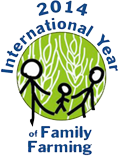Changing the Future of Global Agriculture: An Interview with Mark Holderness

Dr. Mark Holderness is a food scientist who uses science to address agricultural and rural development challenges. He began his career as a cocoa pathologist in Papua New Guinea and has since gone on to work on agricultural projects around the world. He worked with CAB International, an international nonprofit committed to solving agricultural and environmental problems, to reduce pests and diseases in rice, cocoa, bananas, vegetables, and oil palm, and he was Board Vice-Chair for AVRDC, the World Vegetable Center.
Dr. Holderness is now Executive Secretary of the Global Forum on Agricultural Research (GFAR). GFAR is a unique multi-stakeholder forum that brings together a broad range of experts—regional and international organizations, farmers, NGOs, private companies, researchers, educators, and advisors—to explore and strengthen the value of agricultural research and innovation in meeting key food security and development needs. This year, Food Tank is partnering with GFAR to showcase challenges and developments for smallholder farmers during the International Year of Family Farming (IYFF). Food Tank recently had the opportunity to speak with Dr. Holderness about GFAR’s goals, challenges, and current initiatives to improve global agriculture.
Food Tank (FT): GFAR’s goal is to encourage agricultural research and communication about farming. Why is this mission critical now?
Dr. Mark Holderness (MH): We know that agricultural research and innovation give some of the greatest possible returns in rural development and agriculture, but we also know they are not enough by themselves. We need to use new scientific knowledge to change people’s lives, and for new innovations to impact productivity and sustainability and to improve the nutritive value of foods. These changes are essential to face the huge challenges that are ahead. The world population is projected to grow to nine billion by 2050, and those new mouths have to be fed—not just by producing more but by also bringing an end to hunger and poverty. We must also better nutrition in order to avoid the obesity epidemic that is now costing wealthier and emerging economies billions in healthcare costs.
Rural smallholders are the great majority of the world’s farmers, but they’re leaving their farms in droves, out of desperation; they’re going to cities to find employment. We need to create viable agricultural incomes and equitable opportunities in food production so that young people will build careers in agriculture.
All of these challenges require new knowledge and new approaches to achieve a healthy future for humanity.
FT: GFAR connects an enormous number of parties, including regional organizations and farmers, NGOs, and research scientists. What is the biggest challenge to coordinating so many voices, goals, and ideas?
MH: It’s a very good question, but I think the biggest challenge is also the greatest strength of GFAR. People have lived for far too long in silos of their own institutions, thinking about their own immediate goals and not looking at the big picture. So, a lot of what we do is helping people to think outside of their own boxes in order to be more effective in achieving the development goals that we all strive for. In reality, no sector has all the answers, and each has an important role to play in working with others towards common goals.
Of course, it can be hard to deal with very different institutional, individual, and cultural perspectives. After all, farmers face complex, interacting challenges every single day. What we need to do is look much more at how we can bring together new forms of knowledge, new respect and understanding for each other’s forms of knowledge, and then link science back with society.
FT: GFAR puts a strong emphasis on integrating poor rural farmers, women, and youth into conversations about agriculture. How do you connect to these underrepresented peoples? What do they contribute to agricultural research?
MH: These are all neglected areas. Agricultural research has tended to take a gender-blind view, that men and women will find new technologies equally useful. But the more we’ve been researching, the more we find that women have a very different agenda for where they need innovation. For example, a study in Niger showed that men look for greater agricultural productivity, whereas women look for less drudgery and for ways to expend less energy in the field, which frees up time for other activities and opportunities. So we have to remember that gender-blind technologies are not gender neutral. GFAR has created an open process called the Gender and Agriculture Partnership (GAP), which is an inclusive space for anyone who is concerned about economically empowering women in rural areas to share their knowledge, build partnerships and enterprises, and create change.
The same goes for youth in a sense. For many years, we’ve been developing Young Professionals for Agricultural Development (YPARD), a network run explicitly by and for young people. It now has 10,000 members, each of whom want to have a voice in shaping the future of agriculture. With farmers aging, it’s vital. Youth don’t have access to land, they don’t have access to inputs, they don’t have the opportunity to make a viable living and grow their own livelihood. So it’s about creating opportunity, not just in agricultural production but in all the associated industries.
FT: What are examples of women-led enterprises?
MH: If you look at India, an entire dairy industry was built on the one-woman-one-cow principle of providing women economic opportunity to grow their own small business. Now, lots of these small businesses add up to one enormous dairy industry. So it’s not about just the technical inputs, but the environment, which enables women to access markets and be supported by others. Other examples include seed and other small and medium-sized enterprises in Africa, where a number of women have succeeded very well as traders and dynamic market innovators.
FT: How do GFAR and its partners integrate traditional farming methods with newer methods developed from contemporary research?
MH: Farmers are central to our processes. We take a forward-looking approach and work with communities to help them to explore possible future scenarios for their own systems. What might be the shape of their land and farming systems in 20 years’ time? Do they want a viable agricultural livelihood available to their children? What needs to change in order to help those children? Do they see threats of climate change happening? What does that mean for how they might need to change their farming system?
These sorts of questions are helping communities think through some of the alternative futures available to us. Depending on the community’s desired scenario, we can examine what technologies we need to use to achieve these futures. It’s very much about informing choice and farmers consciously thinking about what they’re looking for from their systems. It’s not about focusing on single technologies, as that’s often a sterile path that polarizes opinions and doesn’t take account of the complex realities of production and consumption. We’re thinking about both the positive and negative implications of technologies so we can empower and inform communities’ choices to create the future they wish for.
FT: GFAR is a key organizer of the biennial Global Conference on Agriculture Research for Development (GCARD). Why are these conferences unique, and what real changes do they initiate for technological development in agriculture?
MH: The GCARD is a totally unique venture; it’s the only place in the world where farmers, civil society, the public sector, research, extension, education, and international organizations all come together in a totally objective space to discuss what we want for the future and what we have to do to get there. It’s really all about two things: shaping the future needs of agriculture and how research, innovation, new ideas, and new knowledge can help us get there. It’s special in that it’s not a one-off meeting but a process to steadily shape key areas of activity, like rethinking our research and the way it impacts society.
We’re now taking a fresh look at agriculture’s future needs and how we need to shape our international research so that it compliments and adds value to national agendas. It’s about identifying national rural development agendas from the perspectives of farmers and communities, not just the government. And those agendas are changing quickly—a few years ago, we heard very little mention of gender, nutrition, resilience, or even climate change and now they’re all becoming very big issues. If research can’t meet future needs then it has no purpose. We have to get it right now to make sure that our children have a future.
FT: To wrap up, what kinds of new initiatives can people anticipate from GFAR in the future? And in particular, what can they expect from the upcoming GCARD 3?
MH: A new initiative that’s coming up is women in enterprise development, which is becoming a very big theme for us. We are also starting a dialogue with rural communities in the Mediterranean to address some issues like the huge youth unemployment rate in the region and the problems caused by urban drift that have led in turn to recent government crises. We believe that by addressing root causes, promoting agriculture, and creating viable rural livelihoods, we can reduce the pressure on entire societies to give them healthy futures.
In the GCARD 3 process that starts this year, we’re focusing on reshaping the international agenda. We’re working directly with the Consultative Group on International Agricultural Research (CGIAR), which is developing a new strategic results framework that will be used as a basis for country-led dialogues on how international research can best add value to national capabilities and help meet national needs. So many national systems are under-resourced, so we’re working with a range of partners to set up a whole new investment and capacity development facility for national research and innovation systems. We want to build effective pathways that turn new ideas into opportunities for farmers on the ground and eventually into business opportunities for farmers to grow out of poverty. Through these processes, billion dollar investments are being shaped by communities themselves.



